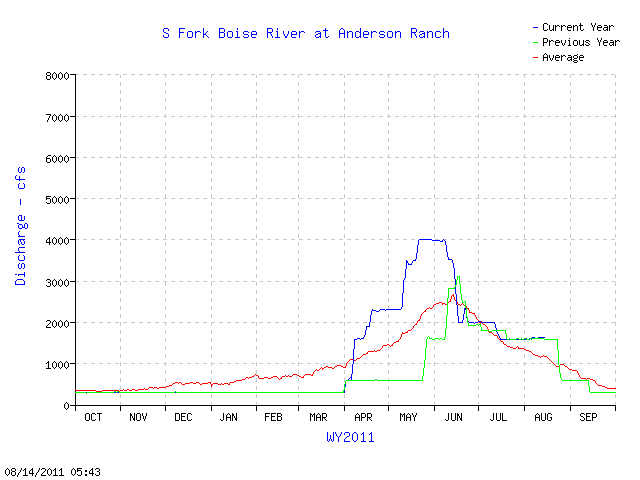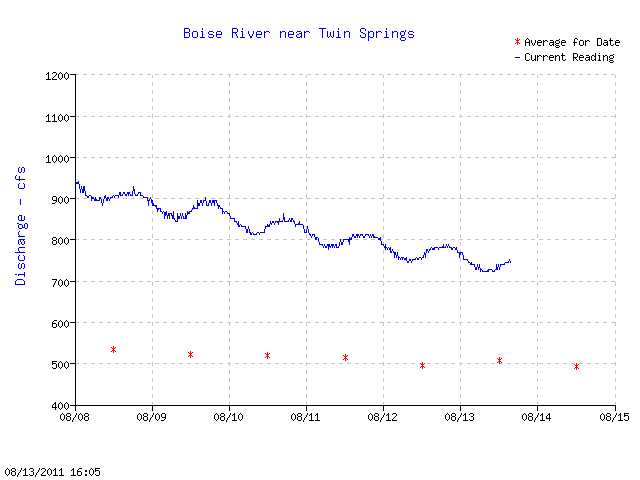This is the time of summer when thoughts and conversations among fly anglers turn to the question of when Anderson Ranch Dam flows will drop from the summer boating flows to the wading flows of late summer and fall.
 You might hear hushed, brief conversations at the fly shops. The USGS and Bureau of Reclamation river flow web pages get more looks. People start to look at some days in September they can block on their calendar.
You might hear hushed, brief conversations at the fly shops. The USGS and Bureau of Reclamation river flow web pages get more looks. People start to look at some days in September they can block on their calendar.
Unlike the precision of Friday night lights coming on the last weekend in August for high school football, the exact days for the flows dropping is different year to year. Our prediction is after the jump:
A look back at the past 25 years shows the flows start their descent in mid August, especially in years with more than adequate water supplies. We think conditions point to flows dropping starting around August 15h.
Part of this guess is based on our analysis of the information in this table:
| Last boating flows day | Flows (cfs) | Anderson Reservoir (acre feet) |
| 8/27/85 | 1710 | 261,982 |
| 7/6/86 | 1480 | 417,417 |
| 9/15/86 | 1700 | 333,770 |
| 8/24/87 | 1570 | 128,015 |
| 7/31/88 | 1440 | 146,230 |
| 9/4/89 | 1460 | 252,105 |
| 8/14/90 | 1610 | 184,656 |
| 8/18/91 | 1500 | 96,119 |
| 7/12/92 | 1160 | 31,065 |
| 8/8/93 | 1600 | 357,439 |
| 8/28/94 | 1580 | 55,177 |
| 8/6/95 | 1600 | 398,561 |
| 7/31/96 | 1590 | 393,585 |
| 8/3/97 | 1560 | 389,767 |
| 8/16/98 | 1580 | 358,795 |
| 8/15/99 | 1590 | 350,477 |
| 8/20/00 | 1560 | 277,992 |
| 7/8/01 | 1260 | 111,322 |
| 9/8/02 | 1460 | 136,519 |
| 9/1/03 | 1200 | 277,743 |
| 8/15/04 | 1600 | 221,549 |
| 8/21/05 | 1490 | 229,498 |
| 8/27/06 | 1600 | 285,184 |
| 9/9/07 | 1660 | 126,122 |
| 9/1/08 | 1860 | 260,927 |
| 8/23/09 | 1600 | 290,164 |
| 8/22/10 | 1599 | 297,810 |
For the past 25 years since a water operations manual was adopted in 1985 the summer flows have been managed at more or less 1,600 cfs. In recent years a couple hundred more cfs have been added to move stored water through the system for salmon migration in the lower Snake River to attempt to mitigate for the effects of the Army Corps dams.
If there is discernable pattern from the dates in the table it’s a little difficult to see. Generally, the water managers are balancing the demands for irrigation in the Treasure Valley while also aiming for storing water as high up in the system as possible. Anderson Ranch Reservoir provides the most options to water managers for the following irrigation season. So in above average water years it seems that flows can being to drop earlier than in below average years. Some exceptions are the very below average conditions such as successive drought years. Take 1992 as an example. The flows were released and boating flows were exhausted by early July. 1992 is an extreme case, however, and not one that will be much help for us when thinking about 2011.
The above average water years in the late 1990s indicate the flows will drop in mid August. A large amount of water was stored in the reservoir, saving much of it for delivery next year. As of this writing there is more than 350,000 acre feet in Anderson Ranch. That’s another attribute of an above average precipitation year.
Anderson Ranch reservoir is holding a lot more water today than it was a year ago. When looking at the flow releases in 2010 and 2009 the table above and the chart below shows it was late August when the flows were cut from the 1,600 cfs rate.
So the blue line in the chart above shows 2011 has been tracking 2010 flows since mid July. Will be blue line continue to track last year’s green line? Probably not much longer. We know there is more water in the system helping address irrigation needs and Lucky Peak and Arrowrock can meet those demands. Thus, less demand for the water stored in Anderson Reservoir.
Another factor, although minor, is the natural base flows from the Boise River headwaters continue to be well above average. This graph of the Twin Springs gage is instructive:
Based on these indicators we appear poised on the flow transition, and the South Fork Boise will start the step down to the fall flows of 600 cfs.
So in the tradition of Chris Berman the “Swami” we will go out on a limb and call it: August 16 the flows will be dropping.









2 Responses to When South Fork Flows Drop: A History Lesson and a Prediction